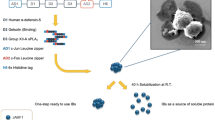Abstract
The genetic library of α-helical amphipathic peptides, 20 amino acid long, was designed and expressed under the T7 promoter in the E. coli JM109(DE3) and BL21 (DE3). Clones that inhibited the growth of the host cell were screened by the relative size of colonies on the plates. Clones which strongly inhibited growth of Escherichia coli JM109(DE3) were further selected. The method developed in this study is useful for the structure activity relationship study of antimicrobial peptides.
Similar content being viewed by others
References
Andreu D, Rivas L (1998) Animal antimicrobial peptides: an overview. Biopolymers 47: 415-433.
Blum JH, Dove SL, Ann Hochschild, Mekalanos JJ (2000) Isolation of peptide aptamers that inhibit intracellular processes. Proc. Natl. Acad. Sci. USA 97: 2241-2246.
Boman HG (1995) Peptide antibiotics and their pole in innate immunity. Annu. Rev. Immunol. 13: 61-92.
Chan RYK, Palfree RGE, Congote LF, Solomon S (1994) Development of a novel type of cloning vector for suicide selection of recombinants. DNA Cell Biol. 13: 311-319.
Kitamura A, Kiyota T, Tomohiro M, Umeda A, Lee S, Inoue T, Sugihara G (1999) Morphological behavior of acidic and neutral liposomes induced by basic amphiphilic-helical peptides with systematically varied hydrophobic-hydrophilic balance. Biophys. J. 76: 1457-1468.
Liang JF, Kim SC (1999) Not only the nature of peptide but also the characteristics of cell membrane determine the antimicrobial mechanism of a peptide. J. Pept. Res. 53: 518-522.
Maloy WL, Prasad Kari U (1995) Structure-activity studies on magainins and other host defense peptides. Biopolymers 37: 105-122.
Mertens N, Remaut E, Fiers W (1995) Tight transcriptional control mechanism ensures stable high-level expression from T7 promoter-based expression plasmids. BioTechnology 13: 175-179.
Scholtz JM, Baldwin RL (1992) The mechanism of alpha-helix formation by peptides. Annu. Rev. Biophys. Biomol. Struct. 21: 95-118.
Shahsavari M, Peyman GA, Niesman MR, Miceli MV, Jaynes J (1995) Shiva-1: in vitro and in vivo tests of the effects of a novel, synthetic, lytic peptide on ocular cells. Int. Ophthalmia. 19: 29-34.
Tiozzo E, Rocco G, Tossi A, Romeo D (1998) Wide-spectrum antibiotic activity of synthetic, amphipathic-peptides. Biochem. Biophys. Res. Commun. 249: 202-206.
Tossi A, Sandri L, Giangaspero A (2000) Amphipathic, α-helical antimicrobial peptides. Biopolymers 55: 4-30.
Zhang L, Falla T, Wu M, Fidai S, Burian J, Kay W, Hancock REW (1998) Determinants of recombinant production of antimicrobial cationic peptides and creation of peptide variants in bacteria. Biochem. Biophys. Res. Commun. 247: 674-680.
Author information
Authors and Affiliations
Rights and permissions
About this article
Cite this article
Choi, KC., Kim, HR., Park, YS. et al. Design and screening of in vivo expressed antimicrobial peptide library. Biotechnology Letters 24, 251–256 (2002). https://doi.org/10.1023/A:1014076426705
Issue Date:
DOI: https://doi.org/10.1023/A:1014076426705




